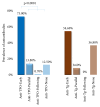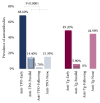Significance of Anti-TPO as an Early Predictive Marker in Thyroid Disease
- PMID: 31467701
- PMCID: PMC6699358
- DOI: 10.1155/2019/1684074
Significance of Anti-TPO as an Early Predictive Marker in Thyroid Disease
Abstract
Even though most thyroid subjects are undiagnosed due to nonspecific symptoms, universal screening for thyroid disease is not recommended for the general population. In this study, our motive is to showcase the early appearance of thyroid autoantibody, anti-TPO, prior to the onset of thyroid hormone disruption; hence the addition of anti-TPO in conjunction with traditional thyroid markers TSH and FT4 would aid to reduce the long-term morbidity and associated health concerns. Here, a total of 4581 subjects were tested multiple times for TSH, FT4, anti-TPO, and anti-Tg and followed up for 2 years. We streamlined our subjects into two groups, A1 (euthyroid at first visit, but converted to subclinical/overt hypothyroidism in follow-up visits) and A2 (euthyroid at first visit, but converted to hyperthyroidism in follow-up visits). According to our results, 73% of hypothyroid subjects (from group A1) and 68.6% of hyperthyroid subjects (from group A2) had anti-TPO 252 (±33) and 277 (±151) days prior to the onset of the thyroid dysfunction, respectively. Both subclinical/overt hypothyroidism and hyperthyroidism showed a significantly higher percentage of subjects who had anti-TPO prior to the onset of thyroid dysfunction compared to the combined control group. However, there was no significant difference in the subjects who had anti-Tg earlier than the control group. Further assessment showed that only anti-TPO could be used as a standalone marker but not anti-Tg. Our results showcase that anti-TPO appear prior to the onset of thyroid hormone dysfunction; hence testing anti-TPO in conjunction with TSH would greatly aid to identify potentially risk individuals and prevent long-term morbidity.
Conflict of interest statement
Siriwardhane and Ashman are employees of Vibrant America LLC. Krishna, Ranganathan, Jayaraman, Wang, Bei, Rajasekaran (K), Rajasekaran (J), and Krishnamurthy are employees of Vibrant Sciences LLC.
Figures



Similar articles
-
Associations between metabolic syndrome, serum thyrotropin, and thyroid antibodies status in postmenopausal women, and the role of interleukin-6.Endokrynol Pol. 2015;66(5):394-403. doi: 10.5603/EP.2015.0049. Endokrynol Pol. 2015. PMID: 26457493
-
[Comparison of the effect of different diagnostic criteria of subclinical hypothyroidism and positive TPO-Ab on pregnancy outcomes].Zhonghua Fu Chan Ke Za Zhi. 2014 Nov;49(11):824-8. Zhonghua Fu Chan Ke Za Zhi. 2014. PMID: 25603906 Chinese.
-
Thyroid profile and autoantibodies in Type 1 diabetes subjects: A perspective from Eastern India.Indian J Endocrinol Metab. 2017 Jan-Feb;21(1):45-50. doi: 10.4103/2230-8210.195998. Indian J Endocrinol Metab. 2017. PMID: 28217497 Free PMC article.
-
Subclinical thyroid disease: scientific review and guidelines for diagnosis and management.JAMA. 2004 Jan 14;291(2):228-38. doi: 10.1001/jama.291.2.228. JAMA. 2004. PMID: 14722150 Review.
-
Thyroid peroxidase autoantibodies in euthyroid subjects.Best Pract Res Clin Endocrinol Metab. 2005 Mar;19(1):1-15. doi: 10.1016/j.beem.2004.11.003. Best Pract Res Clin Endocrinol Metab. 2005. PMID: 15826919 Review.
Cited by
-
From cranial nerve palsy to seizures-All the signs that lead to secondary Fahr's syndrome.Clin Case Rep. 2021 May 5;9(5):e03669. doi: 10.1002/ccr3.3669. eCollection 2021 May. Clin Case Rep. 2021. PMID: 34084472 Free PMC article.
-
No Effect of Thyroid Dysfunction and Autoimmunity on Health-Related Quality of Life and Mental Health in Children and Adolescents: Results From a Nationwide Cross-Sectional Study.Front Endocrinol (Lausanne). 2020 Sep 2;11:454. doi: 10.3389/fendo.2020.00454. eCollection 2020. Front Endocrinol (Lausanne). 2020. PMID: 32982959 Free PMC article.
-
Insights from a Prospective Follow-up of Thyroid Function and Autoimmunity among COVID-19 Survivors.Endocrinol Metab (Seoul). 2021 Jun;36(3):582-589. doi: 10.3803/EnM.2021.983. Epub 2021 Jun 8. Endocrinol Metab (Seoul). 2021. PMID: 34107601 Free PMC article.
-
Subclinical hypothyroidism and anti-thyroid peroxidase antibodies in primary open-angle glaucoma: A case-control study.Indian J Ophthalmol. 2024 Feb 1;72(2):228-231. doi: 10.4103/IJO.IJO_603_23. Epub 2023 Dec 15. Indian J Ophthalmol. 2024. PMID: 38099584 Free PMC article.
-
Autoimmune thyroid status in subclinical thyroid disorders in patients attending a tertiary care center in Nepal: a hospital-based cross-sectional study.BMC Endocr Disord. 2023 Oct 11;23(1):221. doi: 10.1186/s12902-023-01480-6. BMC Endocr Disord. 2023. PMID: 37821852 Free PMC article.
References
-
- Hollowell J. G., Staehling N. W., Flanders W. D., et al. Serum TSH, T4, and thyroid antibodies in the united states population (1988 to 1994): National health and nutrition examination survey (NHANES III) The Journal of Clinical Endocrinology & Metabolism. 2002;87(2):489–499. doi: 10.1210/jcem.87.2.8182. - DOI - PubMed
-
- U.S. Preventive Services Task Force. Screening for thyroid disease: recommendation statement. Annals of Internal Medicine. 2004;140(2):125–127. - PubMed
LinkOut - more resources
Full Text Sources
Miscellaneous

